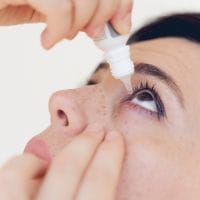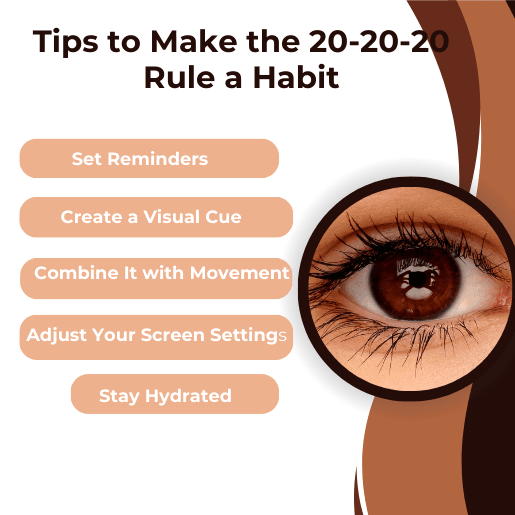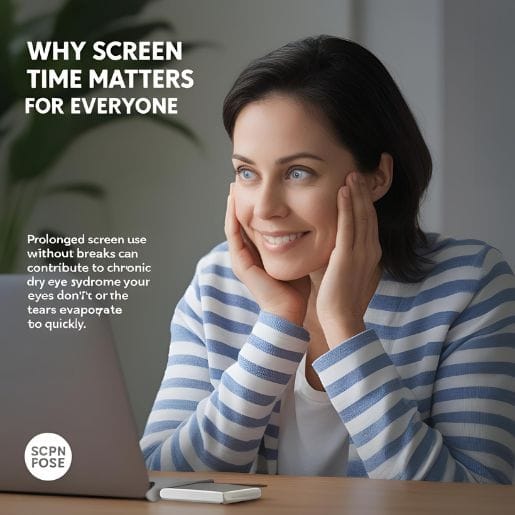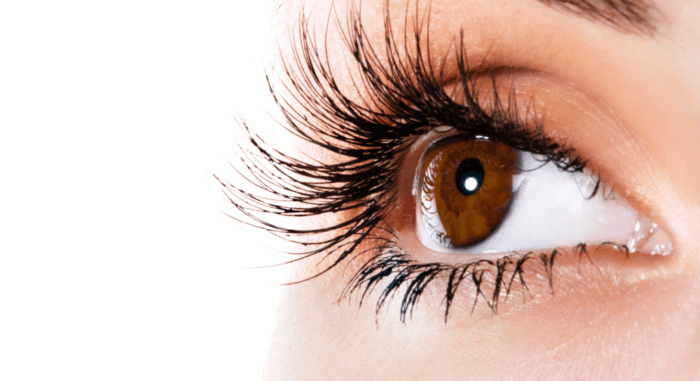In today’s digital age, screen time relief isn’t just a luxury—it’s a necessity. Whether you’re working on a laptop, scrolling through your phone, or binge-watching your favourite show, prolonged screen time can take a toll on your eyes. Enter the 20-20-20 rule, a simple yet powerful technique to reduce eye strain and give your eyes the break they deserve. In this blog, we’ll dive into what the 20-20-20 rule is, why it’s essential for digital eye strain relief, and how you can easily make it part of your daily routine.
What is the 20-20-20 Rule?
The 20-20-20 rule is a straightforward method to combat the effects of excessive screen time. Here’s how it works:
- Every 20 minutes, pause from screen time.
- Focus on an object approximately 20 feet (around 6 meters) away.
- Keep your gaze on it for a minimum of 20 seconds.
This simple habit helps reset your eyes, reducing strain and preventing discomfort caused by prolonged screen use.

Why Do We Need Screen Time Relief?
With the rise of remote work, online learning, and endless streaming options, many of us spend hours glued to screens. This constant exposure can lead to digital eye strain (also known as computer vision syndrome), which includes symptoms like:
- Dry, itchy, or irritated eyes
- Blurred vision
- Headaches
- Neck and shoulder pain
- Difficulty focusing

The 20-20-20 rule is a proven way to combat these issues by giving your eyes regular breaks and encouraging natural blinking, which keeps them moist and healthy.
How the 20-20-20 Rule Provides Screen Time Relief
The 20-20-20 rule stands out for its effortless and straightforward approach. Here’s how it works to protect your eyes:

Reducing Eye Fatigue
In today’s digital world, prolonged screen exposure can strain your eyes, causing discomfort, dryness, and headaches. This happens because focusing on screens for extended periods forces your eye muscles to work continuously without rest. Extended screen use may gradually cause visual discomfort, often recognized as computer vision syndrome.
How It Helps: The 20-20-20 rule is a simple yet effective technique to prevent eye fatigue. The rule suggests that every 20 minutes, you should look at something 20 feet away for at least 20 seconds. This brief pause allows the eye muscles to relax and reduces the strain caused by prolonged screen use. Practicing this habit regularly can improve focus, reduce discomfort, and maintain overall eye health.
According to the American Optometric Association (AOA), taking regular screen breaks is essential to prevent digital eye strain. The AOA emphasizes that consciously following the 20-20-20 rule throughout the day can significantly reduce symptoms like dry eyes, headaches, and blurred vision (American Optometric Association, 2024).
By incorporating this rule into your daily routine, you can protect your vision and maintain long-term eye health, especially if you work in front of screens for extended hours.
Prevents Dry Eyes

One of the most common issues caused by prolonged screen time is dry eyes. When we focus on screens—whether it’s a computer, phone, or tablet—we tend to blink less frequently. In fact, studies show that people blink 66% less while using digital devices compared to normal blinking rates. This reduction in blinking can lead to insufficient tear production, causing your eyes to feel dry, itchy, and irritated.
This is where the 20-20-20 rule comes to the rescue. By taking a break every 20 minutes to look at something 20 feet away for 20 seconds, you’re not only giving your eyes a chance to refocus but also reminding yourself to blink more often. Blinking is essential because it spreads tears evenly across the surface of your eyes, keeping them lubricated and comfortable.
Additionally, the 20-second break allows your eyes to recover from the strain of staring at a screen, reducing the risk of dryness and discomfort. Over time, this simple habit can help prevent chronic dry eye syndrome, a condition that can lead to more serious eye health issues if left untreated.
Tip: During your 20-second breaks, consciously blink a few times to ensure your eyes stay moist. You can also use artificial tears or eye drops if dryness persists.
By incorporating the 20-20-20 rule into your daily routine, you’re not only protecting your eyes from dryness but also promoting long-term eye health. It’s a small change that can make a big difference in how your eyes feel at the end of the day.
Improves Focus
In today’s fast-paced digital world, maintaining focus while working or studying on screens can be challenging. Prolonged screen time often leads to mental fatigue, making it harder to concentrate and stay productive. This is where the 20-20-20 rule proves to be a game-changer. By taking short, regular breaks, you give your brain and eyes a chance to reset, which can significantly improve your ability to focus.
When you stare at a screen for too long, your eyes are constantly working to maintain focus on close-up objects. This can cause your eye muscles to become strained, leading to blurred vision and difficulty concentrating. Additionally, the mental effort required to stay focused on a task for extended periods can drain your cognitive resources, leaving you feeling tired and less productive.
The 20-20-20 rule helps combat this by encouraging you to look at something 20 feet away for 20 seconds every 20 minutes. This short break allows your eyes to relax and refocus, reducing strain and fatigue. At the same time, it gives your brain a momentary pause, helping you return to your screen with a refreshed and clearer mindset.
Research supports the idea that taking regular breaks can enhance focus and productivity. For example, a study published in the Journal of Occupational Health found that short breaks during work tasks can reduce mental fatigue and improve overall performance. By incorporating the 20-20-20 rule into your routine, you’re not only protecting your eyes but also boosting your ability to stay focused and efficient throughout the day.
Tip: Use your 20-second breaks to take a few deep breaths or stretch your body. This can further enhance your focus and energy levels when you return to your screen.
By making the 20-20-20 rule a habit, you’ll notice a significant improvement in your ability to concentrate, work efficiently, and stay productive—even during long hours of screen time.
Tips to Make the 20-20-20 Rule a Habit
Incorporating the 20-20-20 rule into your daily routine doesn’t have to be complicated. Here are a few useful suggestions to help you begin.

1. Set Reminders
Use apps like Eye Care 20 20 20 or Time Out to remind you to take breaks. You can also set alarms on your phone or computer.
2. Create a Visual Cue
Place an object (like a clock, plant, or picture) about 20 feet away from your workspace. Use it as your focal point during breaks.
3. Combine It with Movement
Use your 20-second breaks to stand up, stretch, or walk around. This not only helps your eyes but also improves circulation and reduces stiffness.
4. Adjust Your Screen Settings
Reduce glare by adjusting your screen brightness and using blue light filters. Set your screen at eye level and roughly an arm’s length from your position.
5. Stay Hydrated
Drinking enough water helps maintain moisture in your eyes, reducing dryness and irritation.
Why Screen Time Relief Matters for Everyone

In the modern digital era, screen usage has become an integral part of everyday life. Whether you’re a student attending online classes, a professional working long hours on a computer, or a casual user scrolling through social media, screen time relief is essential for maintaining healthy vision. Ignoring the signs of digital eye strain—such as dry eyes, blurred vision, headaches, and fatigue—can lead to more serious, long-term eye problems.
For instance, prolonged screen use without breaks can contribute to chronic dry eye syndrome, a condition where your eyes don’t produce enough tears or the tears evaporate too quickly. This can cause persistent discomfort, redness, and even damage to the surface of your eyes if left untreated. Additionally, excessive screen time, especially in children and young adults, has been linked to an increased risk of myopia (near-sightedness), a condition where distant objects appear blurry.
The 20-20-20 rule is a simple yet effective way to combat these issues. By taking a 20-second break every 20 minutes to look at something 20 feet away, you give your eyes a chance to rest and recover. This small habit can prevent eye strain, reduce dryness, and lower the risk of long-term vision problems.
But screen time relief isn’t just about protecting your eyes—it’s also about improving your overall well-being. Eye strain and fatigue can lead to headaches, neck and shoulder pain, and even reduced productivity. By adopting the 20-20-20 rule and other eye care practices, such as using blue light filters, adjusting screen brightness, and maintaining proper posture, you’re not only safeguarding your vision but also enhancing your quality of life.
Tip: Encourage your family, friends, or co-workers to practice the 20-20-20 rule with you. Making it a shared habit can help everyone stay accountable and prioritize their eye health.
In a world where screens dominate our lives, screen time relief is no longer optional—it’s a necessity. By taking small steps today, like following the 20-20-20 rule, you’re investing in your long-term eye health and ensuring that your vision stays clear and comfortable for years to come.
In a world where screens dominate our lives, screen time relief is no longer optional—it’s essential. The 20-20-20 rule is a simple, effective way to protect your eyes from the strain of prolonged screen use. By taking just 20 seconds every 20 minutes to look away, you can reduce discomfort, improve focus, and keep your eyes healthy for years to come.
So, the next time you’re lost in your screen, remember: your eyes deserve a break. Start practicing the 20-20-20 rule today and experience the difference it makes!
Try the 20-20-20 rule today and keep your eyes refreshed…

